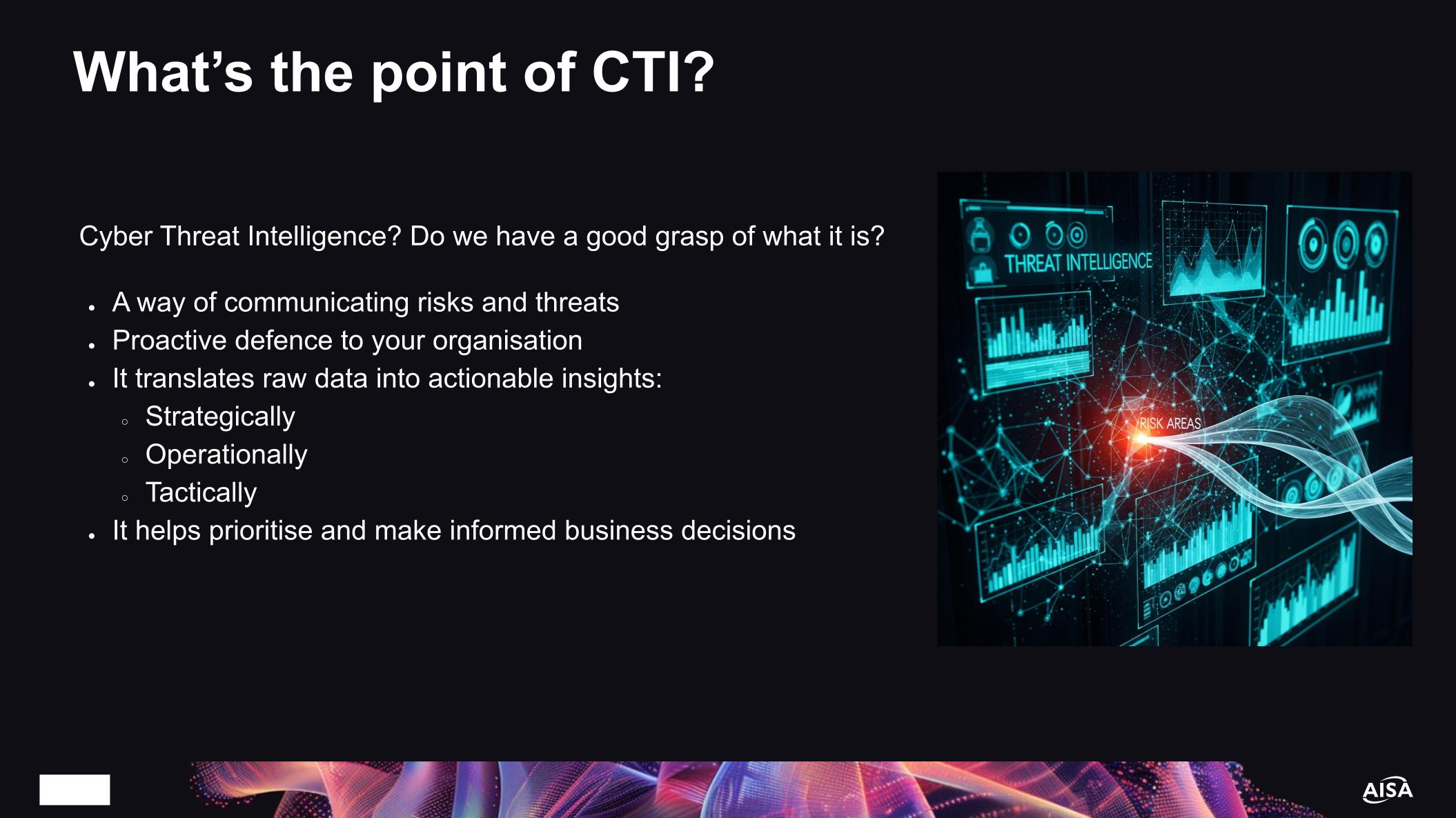Presentations & Appearances
Videos, podcasts and slide decks from public appearances by Cosive staff.

Prescott and Chris explain how the CTI-CMM framework can be used as a powerful tool to get better outcomes from your cyber threat intelligence program.
For those security operations teams reaching higher maturity levels, we see a consistent theme: strong integrations between security tooling and access to integration developers to make it happen. In this presentation, we’ll talk about how to up your game in SecOps engineering and what to expect as you do.
CTI involves a ton of data, and visualisation is the key to understanding it better. Common options are graphs and maps, but we can definitely do better. And guess what? It might not be as tough as you think!
Chris Horsley appeared on the Snake Oilers podcast by Risky Business, hosted by Patrick Gray, to chat about CloudMISP and our CTI consulting capabilities.

While CTI often focuses heavily on technical tools and jargon, analysts should prioritise answering the core questions of ‘who, what, when, where, why, and how’, just like a journalist building a story. There are many parallels between journalistic techniques and CTI practices, including source vetting, confidence assessment, audience awareness, and turning raw information into actionable, contextual insights. The talk encourages CTI professionals to think beyond data collection and focus on producing relevant, accurate, timely, and usable intelligence that reaches the right audience in the right format.
There's a wealth of data visualisations that are easy to produce using generic frameworks, but often they're an answer in search of a question. In this session, I'll briefly talk about some questions I had around a dataset concerning tools used by Russian threat actors, the data visualisation principles used, how it was built, and the insights gained.

In this talk, Chris Horsley shares insights from his experience working with the STIX and MISP standards, explaining their different design philosophies: STIX as a graph-based, committee-driven format, and MISP as an incident-centric, community-driven platform. He highlights translation complexities, such as differences in attributes, objects, taxonomies, and relationships, and discusses the limitations of achieving ‘lossless’ conversion. The talk emphasises that while data can be translated between the two, perfect equivalence isn’t always possible, but ongoing improvements in MISP continue to narrow the gap. Ultimately, Chris encourages practical approaches, awareness of mapping challenges, and managing expectations when working across CTI platforms.

Cosive CTO Chris Horsley stopped by the AUSCERT podcast to chat to Anthony Caruana about the importance of threat intelligence and why context is so important. There's something for every CTI practitioner in this episode.
Cyber threat intelligence (CTI) sharing is something we all agree in theory is an excellent idea – until it comes time to actually do it. In this presentation Cosive CTO Chris Horsley explores solutions to the many challenges that face teams trying to share CTI. Finally, we’ll look at some exciting new ways to improve the lives of CTI analysts to produce better quality and more consistent packages faster.

This presentation will help you understand how to use canary tokens and canary credentials to combat phishing attacks. You'll see what we’re up against when using canary credentials and what we need to implement to not waste our time using canary credentials. Chris also includes a deep-dive into a phishing kit, unearthing common patterns in how phishing kits work, and how they try to avoid countermeasures.

Patrick Gray and Adam Boileau discuss the week’s security news in front of a live audience at AISA’s CyberCon in Canberra. Cosive's Shanna Daly joined the crew on stage to talk about why the infosec industry sucks.

The purpose of this presentation is to provide some practical ideas for handling large amounts of open source intelligence and how to extract and store relevant information.

Cosive CTO Chris Horsley was one of the first to explore the potential of ChatGPT to help us give structure to unstructured threat reports. In this presentation Chris shares the results of his initial experiments using ChatGPT to enhance a piece of unstructured threat intelligence with MITRE ATT&CK codes.
Security Orchestration, Automation and Response, a.k.a. SOAR. It’s the one thing that Kayne Naughton, Cosive’s Managing Director, believes everyone in security should do. In this talk, Kayne argues that almost any organisation can benefit from using automation to perform repetitive tasks and provide context. Human attention should be reserved for making decisions based on this information.
Kayne discusses TTPs (Tactics, Techniques, Procedures) and how knowledge about them can help you to improve the value and robustness of your threat intelligence.
This presentation is aimed at arming System Administrators, Developers and Hobbyists with a collection of tools and techniques to thwart hackers post-exploitation using common Linux features.
Are your security teams / CSIRTs / SOCs actually prepared to use threat intel, big data and machine learning? The answer is often: “no”. Many organizations gloss over the basics, and try to integrate the latest cutting edge technology before they are ready. Learn how to get ready.
As “AI” both advances and becomes more complex, with a dearth of experts who understand and operate it, we are rapidly approaching an era that will enable IT people and their screw-ups to ruin lives on an unprecedented scale.

Kayne demonstrates common mistakes that organizations make managing their passwords and provides solutions to fix them.

STIX 2.0 is a way to structure threat intelligence language. STIX describes the threat intel in a structured format, TAXII then moves the threat intel into a threat intel repository for storage. STIX and TAXII are used by many of the biggest technology companies and governments are driving the adoption process. STIX 2.0 simplifies the process and removes onerous restrictions, making it easier for you to sight things easier and be more descriptive.





